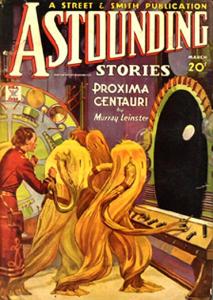The possible asteroid belt around the star HD69830, covered here in a recent entry, caused several days of pondering and a scouring of the Centauri Dreams library. This exoplanetary belt seems to be 25 times as dense as our own, and as close to its parent star as the orbit of Venus is to ours. That would make for an unforgettable celestial display every night, a belt of light cutting across the sky. The idea of a ‘ringed star’ finally drew forth the memory: an old Murray Leinster story called “Proxima Centauri.”
 Published in the March 1935 issue of Astounding Stories (an issue in which future Astounding editor John Campbell would have two stories, one of them under his pseudonym Don A. Stuart), “Proxima Centauri” tells the story of the Adastra, a vast starship a mile in diameter as it makes the first interstellar crossing. Ahead in the viewfinders, Proxima Centauri reveals itself to be surrounded by a glowing ring that comes into view long before the planets in the Proxima system. That ring stayed in my subconscious all these years since I first read the story in Isaac Asimov’s collection Before the Golden Age (New York: Doubleday & Company, 1974).
Published in the March 1935 issue of Astounding Stories (an issue in which future Astounding editor John Campbell would have two stories, one of them under his pseudonym Don A. Stuart), “Proxima Centauri” tells the story of the Adastra, a vast starship a mile in diameter as it makes the first interstellar crossing. Ahead in the viewfinders, Proxima Centauri reveals itself to be surrounded by a glowing ring that comes into view long before the planets in the Proxima system. That ring stayed in my subconscious all these years since I first read the story in Isaac Asimov’s collection Before the Golden Age (New York: Doubleday & Company, 1974).
Make no mistake: “Proxima Centauri” is a creaky tale, freighted with an
implausible (and irritating) romance, and its technology is pure 1930s. Today we talk about starships driven by sails far lighter than the transparent film that wraps a pack of cigarettes. In Leinster’s story, the enormous ship is described as ‘monstrous’ and ‘apparently too huge to be stirred by any conceivable power,” although as the story opens, we see her decelerating:
At a dozen points there flowed out tenuous purple flames. They gave little light, those flames — less than the star ahead — but they were the disintegration blasts from the rockets which had lifted the Adastra from the surface of Earth and for seven years had hurled it on through interstellar space toward Proxima Centauri, nearest of the fixed stars to humanity’s solar system.
Leinster, in reality pulp writer and inventor Will F. Jenkins, would write numerous stories that helped define early science fiction, including many with much more to recommend them than “Proxima Centauri.” His “First Contact” is still remembered as a classic of the genre, as is “Exploration Team,” on the man vs. machine debate for examining other worlds, and “Sideways in Time,” an early tale of parallel universes.
His characters could be one-dimensional but what recommends Leinster and so much writing from this period is the sheer audacity of the concepts. We forget today how breathtaking the fictionalization of interstellar flight once was, bombarded as we are with television and movie images that make these vast journeys routine. Leinster’s crew would encounter a lethal intelligence in the form of a race of intelligent plants before a deus ex machina solution would open up the Centauri system to human colonization. Like I said, it’s a creaky tale, but one of the first in the American science fiction magazines to make the Centauri crossing and a reminder of that sense of participatory awe that readers in that era felt. Can we recapture that awe today?
Not long ago a friend asked why, once the hubbub of the Titan landing had passed, the media seemed to have forgotten Cassini. It’s a question worth pondering in a week that brought us a workable desktop fusion device. The answer to the world’s power power problems it’s not, but Seth Putterman’s team at UCLA has delivered a tool that offers new options in ion propulsion and the prospect of a deeper understanding of fusion’s deep mysteries.
Part of the Centauri Dreams library is a collection of old pulp magazines, garish covers largely intact, culled from dealers and other collectors over the decades. How odd that their innocent incredulity and hope of future wonders should now appear dated, when the remarkable events of today — from finding new exoplanets to creating fusion in a device the size of a toaster — should rightfully produce even more awe in us.
Putterman’s work is presented in “Observation of nuclear fusion driven by a pyroelectric crystal,” Nature 434, 1115-1117 (28 April 2005). The best collection of Murray Leinster’s short stories is First Contacts: The Essential Murray Leinster (Framingham, MA: New England Science Fiction Association, 1998).


http://philosophyofscienceportal.blogspot.com/2011/04/x-minus-ones-first-contactold-time.html